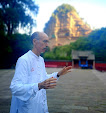

We took an intensive class in Chinese language. Hannah was a beginner in Level A3. I started in a "C" level class but dropped to "B4" level the first day because it was too difficult for me. Two days later I dropped from B4 and ended up in B3 level which was just right. Class levels range from A-F and there are intermediate and advanced classes within those levels. We spent 30 hours a week in class and probably another 4-5 hours a day studying and preparing for the next day. We both learned more than 300 new words in Chinese (Average 25 new words a day. Many days we had to learn much more).
This was my second time at BLCU. Almost ten years to the day I was in the beginning level class there. It was fun to go back and see how the University has grown.
Top: Hannah at the entrance to our building, The College of Intensive Chinese Studies. (Making a "V" sign is very popular there when taking pictures. We have fun adopting that pose.)
Top left: My class. Zhao Laoshi (teacher) (blue shirt) is just right of me and Jiang Laoshi (teacher) (white & blue dress), our grammar instructor, is next to her. Both were excellent teachers. We also had two other teachers for listening and conversation classes. Students came from many countries including Sweden, England, Iran, Russia, Japan, Spain, South Korea, and Malaysia to mention a few.
Bottom: Speaking teacher Zhao Laoshi and student. She was very nice and very patient with us as we stumbled over the words and pronunciation in text we had to read outloud. The blackboard in the background is typical of our class work. Zhao Laoshi never spoke English and it was very rare for the other teachers to speak in English also.





